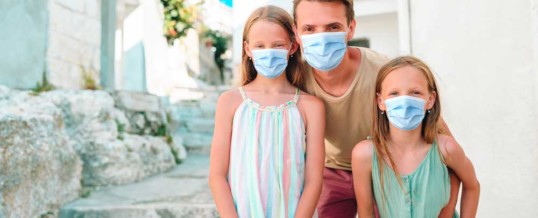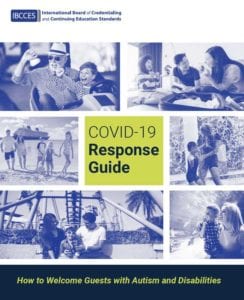
The tourism industry has taken an incredible hit due to the spread of COVID-19, but tourism will resume in time. While COVID-19 has impacted lives worldwide and drastically changed the way we operate businesses, through adaptation and innovation, business owners in tourism and hospitality are beginning to be able to safely open their doors to guests.
With infection rates rising in many states as lockdowns end and businesses reopen, it is clear that things are not going to go back to normal. Organizations will have to find a new normal – a way to operate as safely as possible to minimize the risk of infection for both patrons and employees alike.
In this article we will talk about safety measures and precautions in light of COVID-19, the implications of those safety measures for people with autism or other sensory disorders, and how the Guest Experience 2.0 Training can help your location adjust to the ‘new normal’.
COVID-19 in the United States
The spread of COVID-19 has left many without jobs and in a state of panic and anxiety. As we move forward into an uncertain future, it is imperative that hospitality and tourism operators take preventative health measures seriously to ensure that their guests will remain safe and healthy while starting to enjoy their locations again.
A large population that is at high risk is the autism population. Individuals with sensory disabilities and other special needs may have co-occurring disorders or needs that put them at greater risk of infection or they may be immunocompromised. Those on the spectrum may also have difficulty when it comes to precautions, such as wearing a mask in public. Having a trained staff that is prepared for these situations and equipped to address these issues can ensure that your business is operating within recommended safety guidelines while still creating a comfortable environment for individuals with autism.
Safety Measures to Follow
When it comes to adapting your business to include precautionary measures in order to prevent COVID-19, there are many steps that you can and should take. By doing so, your guests will feel welcome and safe to start enjoying your space again. As we learn more and more about COVID-19 and how it spreads it is important to take this information into account and alert your customers about how you are updating your business operations and practices.
Wearing Masks
The CDC recommends that individuals should wear masks, or cloth face coverings, in order to help reduce the spread of infection when in public. Wearing a mask allows individuals to practice what the CDC calls source control, which is preventing the spread of disease by creating a “barrier that helps prevent respiratory droplets from traveling into the air and onto other people when the person wearing the cloth face-covering coughs, sneezes, talks, or raises their voice”.
COVID-19 can still be spread by those who don’t show any symptoms.
People may be walking around infected, but if they don’t know that they are, they may not feel the need to comply with safety measures. This is why it is so important as a business operator to ensure that all staff and guests are wearing masks and practicing physical distancing, which is staying at least six feet away from one another.
Masks Actually Aren’t For Everyone
However, there are several exceptions. The CDC states that masks should not be worn by children under two years old, anyone with difficulty breathing, and anyone who is unconscious, incapacitated, or not able to remove the mask by themselves.
Many individuals on the autism spectrum may also have difficulty when it comes to wearing a mask. Doing so can cause sensory issues due to touch and can give the individual feelings of confinement, causing anxiety and panic. It is important for your establishment to understand this and, when possible, give individuals on the spectrum the option to not wear a mask. If not possible, communicate all requirements well ahead of time and in multiple forms. You could also consider creating a social story or visual aid to help parents and individuals socialize the idea before they visit.
Another helpful tool to address this challenge is a training program called Guest Experience 2.0 that IBCCES designed. This program can provide education in conflict resolution and sensitivity training for staff so that they feel comfortable addressing situations where guests have concerns about wearing a face mask or other safety requirements.
It is also recommended to put signs with words and symbols along with communication on your website and social media pages to explain to visitors why some guests do not have masks on and how to best operate in the space.
Do Masks Really Work?
Unfortunately, not everyone is taking the wearing of masks as seriously as we should be.
Since COVID-19 has been found to spread mostly through the transmission of respiratory droplets, wearing a mask is one of the most effective ways to prevent the spread of infection, even more so than physical distancing.
In a simulation that was conducted, researchers were able to predict that by having 80 percent of the population wear masks, the spread of COVID-19 would be reduced more than implementing a strict lockdown.
“What you want is 100 percent of people to wear masks, but you’ll settle for 80 percent,” said George Rutherford, MD, a UC San Francisco epidemiologist.
Another experiment that utilized high-speed video was able to observe that hundreds of droplets were generated just from saying a simple phrase. These droplets ranged from 20 to 500 micrometers. However, almost all of the droplets were contained when the mouth was covered with a damp washcloth.
To prove the effectiveness of wearing a mask further, another study conducted involving individuals with influenza or the common cold found that wearing a surgical mask can greatly reduce the spread of these viruses by containing respiratory droplets.
Peter Chin-Hong, MD, an infectious disease specialist said “Compared to wearing a mask, cleaning your iPhone or wiping down your groceries are ‘just distractors.’ There’s little evidence that fomites (contaminated surfaces) are a major source of transmission, whereas there is a lot of evidence of transmission through inhaled droplets.”
There is no guarantee that wearing a mask will prevent the spread of COVID-19 100 percent of the time, but by encouraging your staff and guests to practice this measure you will lower the rate and risk of infection drastically.
“The concept is risk reduction rather than absolute prevention,” said Chin-Hong. “You don’t throw up your hands if you think a mask is not 100 percent effective. That’s silly. Nobody’s taking a cholesterol medicine because they’re going to prevent a heart attack 100 percent of the time, but you’re reducing your risk substantially.”
To learn more about wearing a mask click here.
 More Precautionary Measures to Take – IBCCES Survey Results
More Precautionary Measures to Take – IBCCES Survey Results
In May of 2020, IBCCES conducted a survey of individuals with autism along with parents and caregivers of people on the spectrum. The purpose of this study was to determine their interests, fears, concerns, and needs when planning to travel or visit attractions and destinations.
Communicate on Preferred Platforms
Some helpful insights that were discovered include that individuals with autism and their caregivers prefer to get updates and information from you about safety and accessibility via email, website, and social media. This is very useful to know so that you can ensure you are clearly communicating new guidelines and safety measures on these platforms.
By having the necessary information available to guests beforehand, whether online or in a specific guide, they can be prepared and know what to expect before arriving at your destination. This can make all the difference for families who have an individual on the spectrum.
Enforce Sanitation Practices
In the same survey, when asked if guests would be more likely to visit a destination that practiced enhanced sanitation, hand sanitizer stations everywhere, sanitation wipes for all guests contact areas, 85 percent said yes.
While it is critical to have resources available, such as frequent hand washing stations, you and your staff should also be aware that some individuals with autism may be sensitive to smells. When it comes to selecting cleaning supplies, unscented products are always a safe bet if possible.
In order to communicate new sanitation practices to your customers, especially those with autism, be sure to post new cleaning requirements and protocols on your website and use signs with words and symbols at your destination to keep everyone on the same page.
It may also be helpful to develop a staff rotation schedule to ensure that commonly touched surfaces, such as door handles, tables, and chairs, are being cleaned consistently throughout the day.
Physical Distancing
When asked if the survey participants would be more likely to visit a destination if physical distancing practices were implemented throughout the location, including six foot distance when queuing, table spacing at restaurants, and mobile food ordering, 70 percent said yes.
Visual cues can be very helpful in guiding visitors to leave an appropriate amount of space between their families and other guests, especially in crowded areas. These physical markers can help keep traffic moving and encourage guests walking in opposite directions to have as little contact as possible.
Autism Training for Staff
84 percent of the survey respondents said that they would be more likely to visit a destination if their staff were trained and certified in autism.
With all of the new safety measures and adaptations taking place, those with autism may easily feel overwhelmed and anxious adhering to these new practices. For example, they may flee in order to get away from something that is overstimulating or to find an area that feels safe. When staff is trained in autism they will be equipped with the tools and knowledge they need to handle obstacles like this with a calm demeanor and professional attitude.
Ensure staff, especially guest-facing, are up to date on autism awareness training and COVID-19 health measures
A New Way of Operating During and After COVID-19
As we all adjust to this new way of living, we can reduce the spread of COVID-19 by doing everything possible to take preventative action and communicate these new precautions to guests and staff. Prevention and communication will go far and help everyone to be prepared.
The tourism industry is going to look very different for awhile, but it doesn’t mean we cannot continue moving forward. Now is a unique opportunity for organizations to act as leaders when it comes to the health, safety, and inclusivity of their guests.
The Guest Experience 2.0 training can help to usher your staff into this new paradigm of service with a smile from a distance from a trusted third-party source of training and certification.
Learn More About Certification & Training Options
JUL